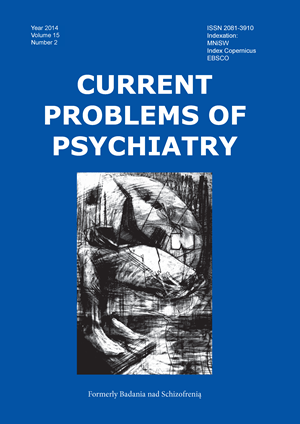Analysis of the impact of various social and demographic factors on the incidenceand level of severity of anxiety in a group of school students
Keywords:
anxiety, studentsAbstract
Introduction. Anxiety is a ubiquitous phenomenon in today's world, particularly affects young people who are faced with the enormity of the challenges related to education, personal development, creating relationships, building a position in the peer group. Previous studies have shown that anxiety is a complex phenomenon, multidimensional and many factors can determine its occurrence and severity. Interesting seems to be the role of social and demographic conditions, to some extent, the prevalence of modifiable as predictors of anxiety. The aim of the study was an assessment of the impact of different social conditions, gender and age on the incidence and severity of anxiety in a group of school students.
Material and methods. The study comprised a group of 202 schoolchildren aged 13 to 21 years. Proven tool for this study is a psychometric test State and Trait Anxiety Inventory (STAI) designed by Charles Spielberger.
Results and conclusions. People of the study group who live outside the family home turned out to be more prone to anxiety. With regard to the study group the risk factors of increased level of anxiety were found to be: a lower level of student's parents formal education, parent’s residence in the less than 50 thousand residents town, the worse material conditions of the family and the student’ s necessity to take a paid work. Social and demographic factors therefore determine the mental processes, which may be of great importance for the further personal and social development of young people.
References
1. Radziwiłłowicz P. Zespoły lękowe (lub tzw. nerwice) W: Landowski J., Radziwiłłowicz P., Bilikiewicz A. red., Psychiatria Repetytorium, Warszawa, Wydawnictwo Lekarskie PZWL 2003, s. 117-131.
2. Lipczyński A. Normalizacja State-Trait Anxiety Inventory (STAI) i możliwość jego stosowania w terapii osób uzależnionych od alkoholu. Psychologia.net.pl-portal psychologiczny [online]. [dostęp 28 sierpnia 2014] Dostępny w internecie: http://www.psychologia.net.pl/artykul.php?level=13
3. Namysłowska I. Rozwój psychiczny człowieka W: Rybakowski J., Pużyński S., Wciórka J. red., Psychiatria T. 1, Wrocław, Elsevier Urban & Partner 2010, s. 245
4. Oguzturk O., Bulbul SH., Ozen NE., Ekici M., Ornek K., Unlu E., Yuksel S.: State and trait anxiety levels of adolescents in a changing society, Kirikkale city, Turkey. J Clin. Psychol. Med. Settings., 2012; 19(2): 235-41
5. Czabała Czesław J., Brykczyńska Celina, Bobrowski Krzysztof, Ostaszewski Krzysztof: Problemy zdrowia psychicznego w populacji gimnazjalistów warszawskich. Post. Psychiatr. Neurol. 2005; 14 (1): 1-9
6. Kulik A, Sądel E: Lęk i jakość życia jako determinanty poczucia beznadziejności u młodzieży. Psychiatr. Psychol. Klin. 2013; 13 (2): 83-91
7. Makara-Studzińska M, Podstawka D, Królik L. Wsparcie emocjonalne a poziom lęku i depresji wśród młodych kobiet stosujących diety odchudzające. Hyg. Pub. Health 2013; 48 (3): 340-345
8. Mazur J, Małkowska-Szkutnik A, Tabak I: Związek między dorywczą pracą zarobkową a używaniem substancji psychoaktywnych oraz problemami szkolnymi uczniów szkół ponadgimnazjalnych. Prz. Lek. 2012; 69 (10): 867-871
9. Iliceto P., Pompili M., Lester D., Gonda X., Niolu C., Girardi N., Rihmer Z., Candilera G., Girardi P.: Relationship between Temperament, Depression, Anxiety and Hopelessness in Adolescents: A Structural Equation Model. Depress. Res. Treat. [online] 2011. [dostęp 28 sierpnia 2014] Dostępny w internecie: http://www.hindawi.com/journals/drt/2011/160175/
10. García-Fernández J.M., Inglés C.J., Martínez-Monteagudo M.C., Marzo J.C., Estévez E.: School Anxiety Inventory: validation in a sample of Spanish secondary education students. Psicothema. 2011; Apr 23(2): 301-307
11. Trzcinska H., Zwierzchowska B., Kozlowski B., Derdowski S., Przybylski G. Analysis of the role of selected demographic and psychological variables (anxiety and depression) as risk factors of inadequate control of bronchial asthma. Ann. Agric. Environ. Med. 2013; 20(3): 504-508.
12. Gagua T., Tkeshelashvili B., Gagua D., McHedlishvili N. Assessment of anxiety and depression in adolescents with primary dysmenorrhea: a case-control study. J. Pediatr. Adolesc. Gynecol. 2013; 26(6): 350-354
13. Zunhammer M., Eberle H., Eichhammer P., Busch V. Somatic symptoms evoked by exam stress in university students: the role of alexithymia, neuroticism, anxiety and depression. PLoS One. [online] 2013; 8(12) [dostęp 28 sierpnia 2014] Dostępny w internecie: http://www.plosone.org/article/info%3Adoi%2F10.1371%2Fjournal.pone.0084911
14. Costarelli V, Patsai A.: Academic examinaition stress increases disordered eating symptomatology in female university students. Eat. Weight Disord. [online] 2012; 17(3): e164-169 [dostęp 28 sierpnia 2014] Dostępny w Internecie: http://www.link.springer.com/article/10.1007/BF03325343


